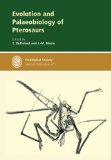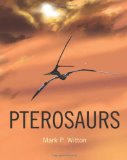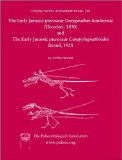Pterosaurs
- A global overview of pterosaur ichnology: tracksite distribution in space and time

- A nearly complete ornithocheirid pterosaur from the Aptian (Early Cretaceous) Crato Formation of NE Brazil

- A new approach to determining pterosaur body mass and its implications for pterosaur flight

- A New Azhdarchid Pterosaur from the Late Cretaceous of the Transylvanian Basin, Romania: Implications for Azhdarchid Diversity and Distribution

- A New Crested Pterosaur from the Early Cretaceous of Spain: The First European Tapejarid (Pterodactyloidea: Azhdarchoidea)

- A new monofenestratan pterosaur from the Kimmeridge Clay Formation (Kimmeridgian, Upper Jurassic) of Dorset, England

- A new pterosaur (Pterodactyloidea, Tapejaridae) from the Early Cretaceous Jiufotang Formation of western Liaoning, China and its implications for biostratigraphy

- A New Small-Bodied Azhdarchoid Pterosaur from the Lower Cretaceous of England and Its Implications for Pterosaur Anatomy, Diversity and Phylogeny

- A Re-examination Of A Specimen Of Pterosaur Soft Tissue From The Cretaceous Santana Formation Of Brazil

- A short history of pterosaur research

- Aerodynamic characters of the cranial crest in Pteranodon

- An external mandibular fenestra and other archosauriform character states in basal pterosaurs

- Anatomy And Systematics Of The Pterosaur Carniadactylus Gen. N. Rosenfeldi (Dalla Vecchia, 1995)

- Evolution of morphological disparity in pterosaurs

- Evolution of the pterosaur pelvis

- Extent of the pterosaur flight membrane

- First evidence of azhdarchid pterosaurs from the Late Cretaceous of Hungary

- First pterosaur remains from the Cretaceous of Poland

- Late Cretaceous pterosaurs from France: a review

- New Pterosaur Specimens From The Kem Kem Beds (upper Cretaceous, Cenomanian) Of Morocco

- New toothed flying reptile from Asia: close similarities between early Cretaceous pterosaur faunas from China and Brazil

- Pterosaurinfo.com
- Pterosaur

- Pterosaur.net
- Pterosaur Database
- Pterosaur distribution in time an space: an atas

- Pterosaur diversity and faunal turnover in Cretaceous terrestrial ecosystems in China

- Pterosaurs – a successful invasion of prehistoric skies

- Pterosaurs from the Lower Cretaceous of Brazil in the Stuttgart Collection

- Taxonomic review of the Ornithocheirus complex (Pterosauria) from the Cretaceous of England

- Toothed pterosaurs from the Santana Formation (Cretaceous; Aptian-Albian) of northeastern Brazil. A reappraisal on the basis of newly described material
- Two bone fragments of ornithocheiroid pterosaurs from the Cenomanian of Volgograd Region, southern Russia

Books about pterosaurs


